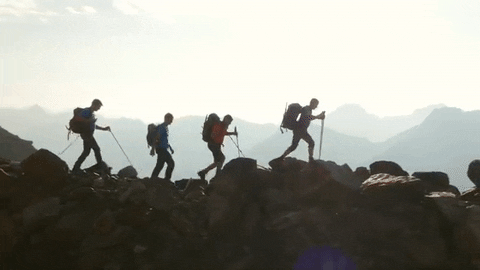Walking stick-
A trusty walking stick is like a Swiss Army knife for the woods.
So… how do we select the right walking stick for hiking and survival purposes?

The following written content by Jim Cobb
From the time we’re young, when we head out on a hike it is almost a compulsion to select some type of walking stick early in the journey. We’re looking for something that’s at least somewhat straight, not so thick that it will be clumsy but not so thin that it is likely to snap easily. As we get older and start to understand how ounces lead to pounds, which in turn can lead to pain, we look for ways to reduce the weight of our hiking load. In doing so, we carefully consider the pros and cons of each item. It’s easy to think of a walking stick as too heavy to make the cut, but these basic hiking tools can offer a lot more than just something to lean on.
How to select a walking stick for hiking and survival purposes

While you can go to any number of outdoor sports retailers and buy a set of snazzy fold-up carbon fiber trekking poles, going with wood for a walking stick keeps the tradition alive, especially if it is a stick you harvest in the wild yourself. Take it home and shave the bark, sand it down, maybe even stain it. Some people will use a wood burner to add images or symbols along the side or use paint to make them look snazzy. I’ve also seen a few people who added little trinkets hanging from cords at the top. So whatever you please, make it uniquely yours.
As a general rule, you want the finished product to be about sternum level. If you go much shorter than that, you’ll limit the usefulness as well as the comfort of the stick. On the other hand, too tall and it will be cumbersome, awkward, and heavy. I like to attach a wrist lanyard so I can rest my arm in it when I’m standing still. For thickness, look for something around 1.5 inches across. Obviously sticks found in the wild aren’t generally straight as an arrow, nor do they have a uniform thickness. However, if you hunt around a bit, you’re likely to find something that will work, maybe with a little customization on your part.
7 uses for a walking stick in the outdoors
1. Lean on it for balance
Perhaps the most important use of the walking stick, certainly the most common, is to aid in balance, especially on rough terrain. Many of us aren’t as young as we once were and a slip could lead to an injury. Or, if you’ve already gotten that far and we’re limping a bit, the walking stick can give you a boost in your step. It will help you keep your balance, as well as regain it if you stumble. It can also give you a boost on steep hills, allowing you to pull yourself along.
2. Check the depth of a stream
Coming across a creek or river isn’t uncommon when you’re out traveling the wilderness. Quite often, it’ll look shallow enough to traverse without needing a bridge. However, all it takes is one unseen drop-off to trip you into the drink, soaking you to the bone and generally ruining your day, as well as your cell phone. You can use your walking stick to check the water depth as you walk by poking the riverbed ahead of you. Bear in mind, though, that even somewhat shallow water, when running fast, can sweep you off your feet. This is especially true during floods.
3. Tie a bindle to your walking stick to carry stuff
While the hobo carrying a bindle on a stick is an oft-portrayed stereotype in cartoons, it is a viable way to carry a few things. Fold a shemagh into a bag for your goodies, then tie it around the end of your walking stick. Toss it over your shoulder and keep on trekking. You can’t carry a lot this way, but you can probably fit more than you may think into a bindle. This is definitely an option to consider if you unexpectedly come across wild edibles, such as blackberries or wild mushrooms.
4. Use your walking stick as a camera monopod
When my wife and I go hiking, we travel at a speed of about three miles, and 75 photos, per hour. If you’re the same way, you can use the walking stick to steady the camera or phone. You don’t need to have any sort of special attachment for the stick, either. Just resting your hand or wrist on top of it will usually suffice.
5. Clear brush and plants from your path
Should you end up off the trail and in the thick of it, you can use a walking stick to move branches, shrubbery, vines, and more out of your way. This can be particularly important if you’re unsure which might be poison ivy, wild parsnip, or other plants that can cause rashes. It can also keep you from stepping on critters as the stick will startle them before your foot gets there.





